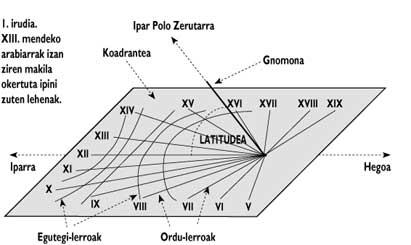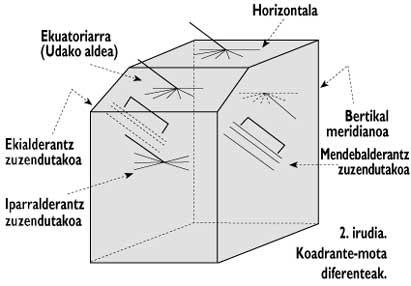Sundials (I)
The systems and units of time used by humans are a direct consequence of astronomical phenomena. The periodic movement of the stars makes the cosmos regulate the life of the Earth and the earthlings. Therefore, the adaptation of vital cycles of plants and animals to these movements cannot be considered as a consequence of chance. Thus, the two main units we use to measure time, year and day are related to the movement of the Earth around the Sun and the rotation of the planet, although these periods are not exact.
The year is the unit of time that the Earth needs to take a full turn around the Sun. Taking as a reference objects outside the system, such as stars, are created stations that regulate the rhythm of life. However, due to the movement of precesion, the inclination of the earth's axis changes every 26,000 years, as if it were a spinning top, forming a circle. Consequently, the seasons also vary and the model we use today is a tropical or legally imposed year, something lower than the sidereal year that is measured with the movement of the stars, 21 minutes and 27 seconds less.
The rotation of the Earth is 23 hours and 56 minutes. During this time, for its part, the Earth rotates around its orbit and adds 4 minutes so that its position on the Sun is stable. This generates a 24-hour movement, that is, a day. However, because the translation speed is not always the same and the axis of the Earth is twisted, those 4 minutes that are added can be misleading. The day of the Sun, that is, the unit of time until the Sun returns to that position looking to the South, does not always have the same duration. This makes the solar hour move away from the average time we usually use. Control of this difference can be done by the so-called solar equation.

Origin of sundials
As mentioned above, the relative position of the Sun and Earth sets the date and time. These parameters, therefore, can be determined by the apparent path that the Sun marks on the horizon. Proof of this movement are the shadows that create objects and for this they have been used in ancient cultures. In Egypt, for example, the shadow that produced an obese was used to know the date and set the hours.
VII. Since the 19th century, in the monasteries the sun was also used: on the southern wall of the monastery a perpendicular stick was placed to fix the canonical hours of prayer.
In any case, the shadow generated by a vertical and horizontal stick is not the safest method to fix the hours, since this shade varies depending on the date. Thus, the duration of the hours was different at each season of the year.
The first steps to solve this problem were the Arabs. In the eighteenth century the stick or folded gnomon was placed. The angle of inclination of the stick with the horizontal plane must be equal to the local latitude and will be calculated when the horizontal plane is parallel to the axis of the Earth (see figure 1).

Different models based on the same philosophy
Although all sundials are based on the same philosophy, they can be of many types. Almost all sundials have two parts: the gnomon or stick that determines the time with its shadow and the square or surface that receives the projection of the shadow and draws the time lines. Depending on the location of the quadrant, different models of clocks can be built: equatorial, when the surface is parallel to the equator; horizontal; vertical meridians or declinants, that is, located or not to the south; lateral, oriented to the east or to the west, that only give hours of morning or morning, or to the north, that give the first and last hours of the day in spring and summer. The most common are vertical quadrant declines placed on one of the southern walls (see figure 2).
As mentioned above, the quadrant plane can be in different positions and the time lines that each model draws will be different. In addition, the shadow of gnomon can be projected into a semisphere or semi-cylindrical.
In addition to those mentioned, there are clocks based on the height of the Sun. These are mobile and must be corrected based on the date. Among the watches of this model, the best known are the “rings”, the “shepherd’s watches” or the L-shaped watch used in Egypt in the past (see figure 3).
Advice to consider who looks
Regardless of the model of the Sol clock, you have to take into account the real time in which you are. Real local time was the unit of time used in each municipality until the last century. In some cases there may be large differences between the standard time currently used and the local real time. This difference depends on three factors: the local geographic length – 48 minutes between Galicia and Catalonia –, the date and time change in summer and winter.
These three factors can be corrected by replacing the original correct time lines with sinusoidal lines and numbers, i.e. by modifying the hours. These corrections are not usually made, so there is usually a big difference between the hours provided by different sundials.






